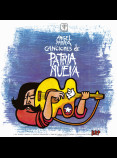How to Promote Music for the People

Since the mid-1960s, the Nueva Canción Chilena [New Chilean Song] movement had been composing tunes and lyrics that were closely identified with the left and became the sound aesthetic of Unidad Popular. This movement for a new folk that celebrated Latin America created music that was directly linked to the country’s everyday reality. Its political commitment made song a tool of liberation and way to speak out against the working class’s living conditions.
Singer-songwriters such as Violeta Parra and Víctor Jara and bands such as Quilapayún and Inti-Illimani were some of its representatives. Setting Pablo Neruda’s poems to music and composing pieces for political campaigns gave rise to true cultural anthems.
Discoteca del Cantar Popular (DICAP), which belonged to the Communist Youth of Chile, was the main record label that spread New Chilean Song. Graphic design played an essential role in spreading its visibility and popularity. The label also organised concerts in factories, trade unions and working-class neighbourhoods. DICAP commissioned Oficina Larrea to design its logo, posters and album covers and liners. This resulted in a diverse, original visual approach which boosted local record production and helped to counter the control of multinational companies.
In addition to serving as a record label, the Industria de Radio y Televisión (IRT)—the nationalisation of RCA Victor— manufactured new appliances to replace imports. Together with the INTEC Industrial Design Area, they developed popular record player designs.

